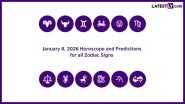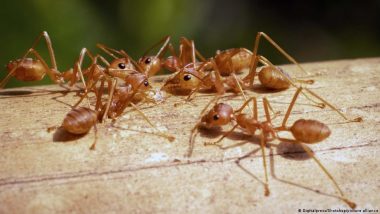Introduced species often become pests in non-native environments, creating monocultures that dilute local biodiversity. A new report focuses on ways to repulse the invaders.When fire ants escaped their home in Argentina and started travelling around the world, often via shipping containers, few would have imagined the damage that the displaced insect would cause.
Also Read | India News | Udhayanidhi Row: Cong Says It Respects All Religions, Others Free to Express Their Views.
From China and Japan to Australia and the US, this venomous alien pushed out and sometimes killed native populations of animals and insects — including those that pollinate local plants, causing long-term changes to vegetation. The ant, which also eats and damages seeds, can severely impact crops and native ecosystems.
Also Read | World News | Canada: 2 Dead, 6 Injured in Shooting at Wedding Reception in Ottawa .
Researchers say that fire ants prefer a warmer climate but are marching north into colder regions as the planet warms, laying waste to biodiversity along the way. Their spread has triggered costly eradication wars, but many have come too late.
The fire ant is symbolic of an unfolding crisis that is the focus of the Invasive Alien Species Assessment Report released today by the Intergovernmental Science-Policy Platform on Biodiversity and Ecosystem Services (IPBES).
More than four years in the making, and produced by 86 experts from 49 countries, the assessment aims to raise public awareness and give policymakers the tools to mitigate the impacts of invasive alien species (IAS).
"Invasive alien species are a major threat to biodiversity and can cause irreversible damage to nature, including local and global species extinctions, and also threaten human well-being," said Helen Roy, UK Centre for Ecology & Hydrology, and co-chair of the IPBES assessment report.
Biological invasions have been a "major factor" in 60% of global animal and plant extinctions, said Anibal Pauchard, assessment co-chair and professor at the Faculty of Forestry Sciences at the University of Concepcion in Chile.
"These are risks and challenges with global roots but very local impacts, facing people in every country, from all backgrounds and in every community — even Antarctica is being affected," Pauchard added.
Globalized economy facilitates alien invasions
Ecosystems have long adapted to the natural migration of plants and animal species across regions.
But the propagation of alien species across borders has rapidly accelerated in the last century, says Emili Garcia-Berthou, professor of Ecology at the University of Girona in Spain, and an expert on IAS impacts on freshwater ecosystems.
In recent times, itinerant species have ridden on the back of a relatively borderless, globalized trade and transport network, he explains.
"Now we have a huge transport capacity, we bring food and commodities from all parts of the world every day." In addition, people move much more than before, importing alien species as they go.
In this globalized world, once isolated regional ecosystems have become increasing vulnerable to outside species that can become monocultures that crowd out local flora and fauna.
These impacts extend to human health, such as the invasive mosquito species currently behind malaria outbreaks in the Horn of Africa.
Comparing IAS to climate change, Garcia-Berthou refers to the outsized impact of introduced animals such as snakes, cats, rats, snakes or pigs on bird and mammal species on islands that carry a high proportion of the world's biodiversity.
Invasive species are implicated in 86% of known extinctions on islands, according to UNESCO — a mere thirty invasive species have contributed to the extinction of some 738 animals worldwide.
In the Pacific island nation of Tonga, for instance, introduced rats have severely repressed or displaced seabird populations, in part by feasting on their eggs and chicks.
Seabirds spread essential nutrients that feed into reef ecosystems and healthy fish stocks. Government and local communities have responded by eradicating rats using poisoned baits on Late Island — home to one of the world's largest intact tropical broadleaf forests, and among the many Tongan island ecosystems to be invaded by rats.
Garcia-Berthou notes that IAS are the second largest cause of biodiversity loss after habitat destruction, and ahead of climate change.
He describes the impact of aggressive mosquitofish, introduced from North America, on freshwater ecosystems in southern Europe. The rapid decline of the Greek native Corfu toothcarp freshwater fish, for example, is partly due to the alien species known to consume the egg and larvae of local fish and outcompete them for food and space.
Climate is further exacerbating these impacts, with warming waters set to expand the reach of non-native mosquitofish in Europe from Mediterranean to northern waters, including Germany, according to the ecology researcher.
Invasive species and climate interlinked
The IPBES Invasive Alien Species Assessment Report has focused strongly on the interconnected impacts of IAS and climate change.
"IPBES has made it very explicit that their assessments are all intermingled with the IPCC (the UN's climate change body) assessments, because you can't really do one without the other," said Corey Bradshaw, professor of Global Ecology at the ARC Centre of Excellence for Australian Biodiversity and Heritage in South Australia.
But though the simple metric of temperature rise can be used to measure climate change, Bradshaw has supported research efforts to create a benchmark to judge the impact of invasive species by estimating the cost of prevention and control.
The global economic cost of managing invasive alien species exceeded $423 billion annually in 2019, with costs having at least quadrupled every decade since 1970, according to the IPBES assessment.
Funding solutions to biological invasions globally
Creating a clear benchmark to measure IAS damage is motivating governments in wealthier countries to fund solutions, said Bradshaw.
"People are more prone to want to invest," he said.
Australia, an island nation that has been highly vulnerable to introduced species, has spent the second highest on IAS management globally behind the US — and ahead of China and Canada.
Most recently, Australian politcial parties have promised significant funds to help eradicate gamba grass, which was introduced into northern Australia as cattle feed in the 1930s and is today fueling wildfires as it spreads across the region.
"They are highly flammable when they dry out," said Bradshaw of the noxious weed, "and massively increase the severity and the extent of fires across much of the semi-arid parts of Australia."
These feral weeds also crowd out native plant species and impact biodiversity, he added.
Meanwhile, Emili García-Berthou says that prevention of the movement of IAS must be a higher priority than management and control – implemented too often once the alien "invasion curve" has already peaked.
The IPBES assessment acknowledges that alien species "preventions" is the most "cost-effective management option."
"There is a lot we can do to prevent new species arriving and establishing in countries or to relocate them when they just arrived," García-Berthou said, describing a need for better biosecurity and monitoring of cross-border travel and transport.
Edited by: Tamsin Walker
(The above story first appeared on LatestLY on Sep 04, 2023 05:50 PM IST. For more news and updates on politics, world, sports, entertainment and lifestyle, log on to our website latestly.com).













 Quickly
Quickly


